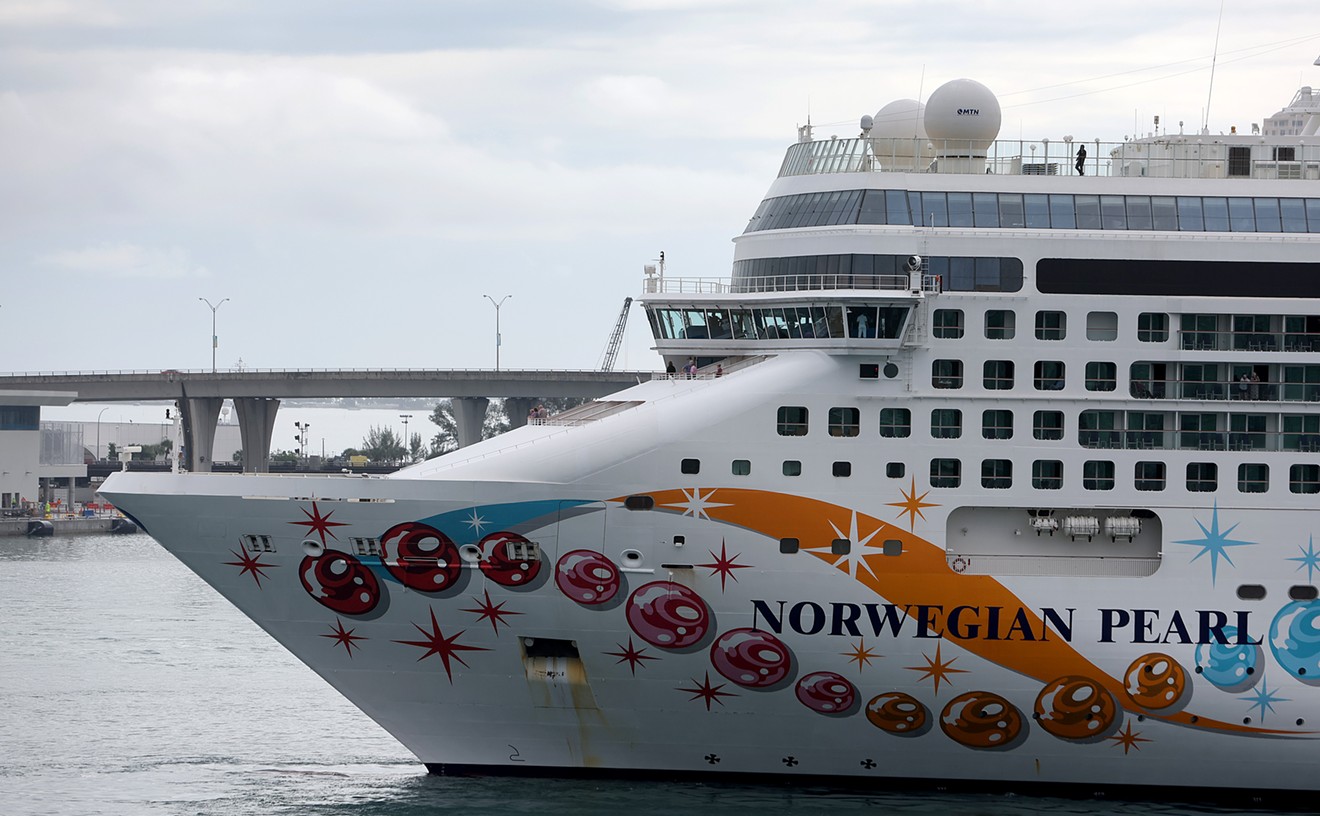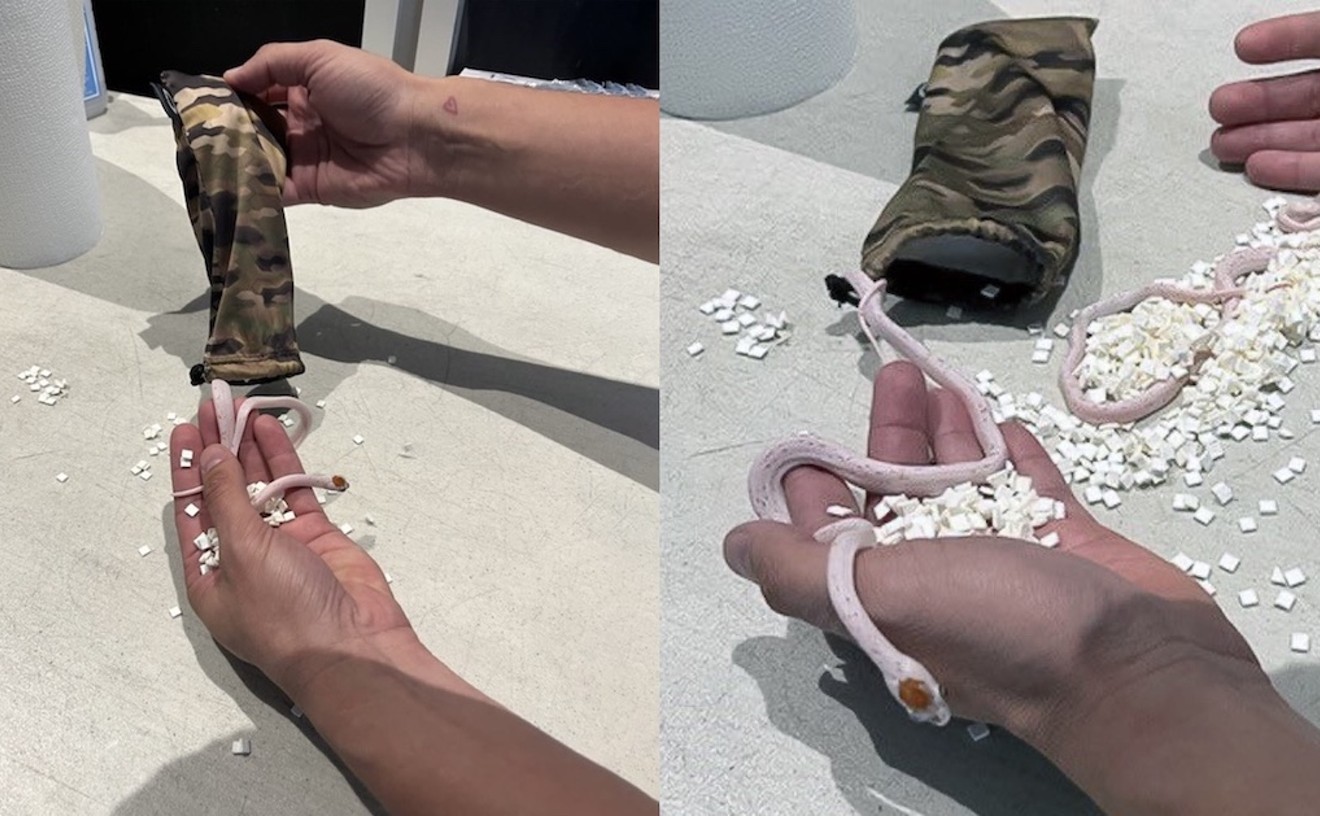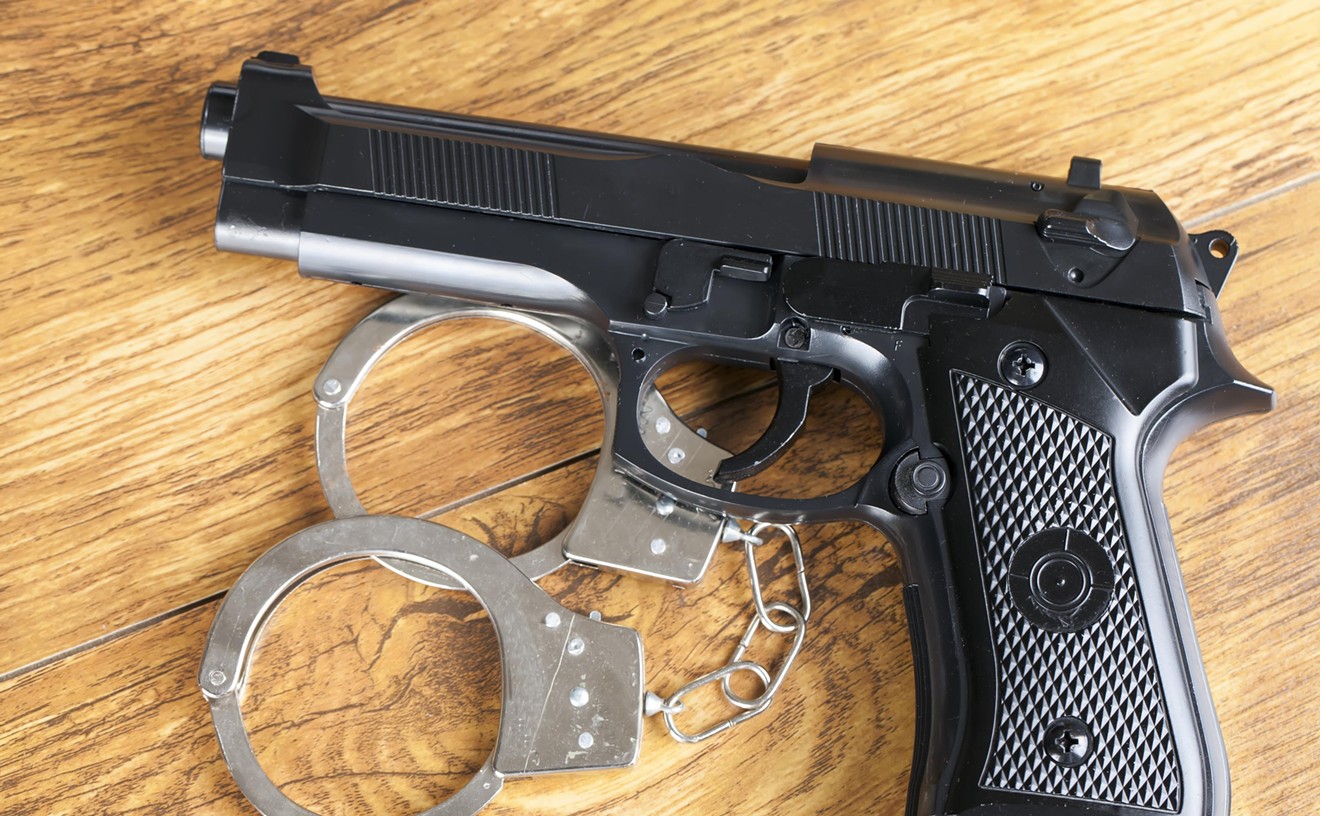A row of high school students holds up handmade signs: "Respect Wynwood"; "Wynwood tiene derechos y los defenderemos"; "No Trailers"; "Why Wynwood?" Seated at a long table flanked by members of a task force formed to resolve the issue, Lunetta is clearly outnumbered. In response to the community's activism, he has significantly scaled back his original proposal, which would have encompassed a total of 160 acres of land. But residents are no more receptive to a plan that would expand the storage area to 90 acres and mean the loss or dislocation of two dozen businesses and more than 600 jobs. For years their neighborhood and adjoining enclaves have been de facto dumping grounds for many things nobody else wants: Drug treatment centers. Housing for the homeless. A jail. A county garbage-collection site. Plus the existing, poorly maintained port storage area, which extends from NW 29th Street seven blocks north, and from North Miami Avenue to NW Second Avenue.
As Lunetta and other speakers are continually interrupted, the port director, a poised, intelligent man, begins to wonder whether he's wasting his time. He has promised, after all, to listen to any and all objections. "Do we have the ability to expand into the community?" he asks, addressing the task force. "No!" comes a shout from the crowd.
Finally, audience comments are formally invited. After two local business owners come forward to warn Lunetta of the disastrous consequences for their employees should the Metro Commission allow the port to overrun the area, Father Jose Luis Menendez, pastor of the Corpus Christi Catholic Church, steps to the microphone. Tall and patrician, with sparse streaks of silver in his wavy hair and beard, the Havana-born man of the cloth is dressed informally, wearing black pants and a black Windbreaker over his clerical collar. But when he takes his hands from his jacket pockets to speak, whispers of "Shhhhhhh" cross the crowd for the first time all evening. "We don't want to be emotional," says the priest, a Spanish lilt blending with the beneficence of his bearing to distract from his anger, "but when we talk about this port extension, we talk about our lives."
Menendez motions to a young woman in the audience who holds a large bundle of dusty leaves wrapped in dark paper, with what appears to be a single red rose in the center. She rises and walks to the stage. "Every time an important person comes to our neighborhood, we bring a flower bouquet," Menendez tells Lunetta. The crowd applauds enthusiastically as the port director extracts himself, beaming, from his cramped seat to accept the offering. "We try to make a bouquet of flowers," the priest continues, "but in our gardens, the only thing we have is dust from your park." Though he virtually spits the last words, the musical, rhythmic quality to his voice, disconcertingly, remains. "Thank you, Mr. Lunetta, for your contribution to us in Wynwood."
The smile has faded from Lunetta's face, but Menendez keeps talking, cataloguing the slights suffered by his neighborhood and promising potent opposition to any move that is contrary to the community's will. "This is not any more a small people without any voice," the priest warns, "because we as one can stop anybody." The cheering audience rises to its feet when he is through.
North of downtown Miami and west of the Omni, Wynwood stretches roughly between NW Twentieth Street and I-195 to the south and north and the Florida East Coast Railroad and I-95 to the west and east, hemmed in by railroad tracks, freeways, and poverty. In the 1960s Latin immigrants, predominantly Puerto Rican, began to displace the middle-class Anglos who were living in the area. The last twenty years have seen more variation, though Wynwood remains heavily Latin and immigrant. It's a transient neighborhood, one in which only 30 percent of residents own homes and unemployment runs as high as 55 percent, according to figures provided by the City of Miami Planning, Building and Zoning Department. Others cite census data indicating that only 17 percent of inhabitants have completed high school, while almost 38 percent live below the poverty line.
For the past few years, between an open-air cafeteria and an apartment building in the heart of Wynwood, the gray concrete body of a new structure has been slowly taking shape on NW Second Avenue near 32nd Street. The form of this two-story edifice crowned with a cross recalls Catholic missions of the past, which took the church to the people who couldn't -- or wouldn't -- come to it. So does the building's function: A sign outside announces the Misi centsn San Juan Bautista (St. John the Baptist), where more than 100 people gather for Mass every Sunday. Most live within walking distance, which is a good thing, because few have cars. Owing to a shortage of pews, when they pray many worshippers must kneel directly on the building's dusty, ice-hard concrete floor.
On a recent afternoon, residents going about their business on NW Second Avenue were likely to have encountered Father Jose Luis Menendez and two of his parishioners hanging banners from light posts. "Welcome to Wynwood," read the banners, which had been paid for with money donated by local entrepreneurs. Tiny details in Father Menendez's ambitious plans for his parish, the banners lent the thoroughfare an old-fashioned feel.
It wasn't long before the priest was accosted by some of his less reputable parishioners, barflies and drug dealers, men who probably had never set foot in Corpus Christi or the Misi centsn San Juan Bautista but who recognized Menendez. "Padre," they called urgently, reaching toward him. "Bendicenos." "Bless us." The priest quietly complied.
Ram centsn Ramos, a Little Haiti shopkeeper who has worked alongside Menendez in many community projects, will tell you such occurrences are the norm. "One time I said, 'Father, here comes a drunk, don't do that, he's wasting your time.' But he says no, he's not. The father puts his hand on the man's head and prays for him. He prays for two or three minutes. He says, 'Dios perdona este ser' and 'ayudele a recuperarse' A things like that." Moreover, concludes Ramos: "He really believes it could happen."
Nevertheless, within a matter of days of Menendez's labors, the lamppost banners near the San Juan Bautista mission had been torn down.
Jose Luis Menendez came to the Corpus Christi Catholic Church at 3220 NW Seventh Avenue nearly six years ago, in March of 1988. It was not a good time to be a priest in any inner-city parish, but it must have been the right time for Corpus Christi. With the advent of Menendez, many say, the community regrouped and began a spiritual, social, and economic renaissance that, although it is still far from flowering, continues. Perhaps his success is due in part to the confluence of social currents, augmented by the force of many souls coming together in time with the same purpose. But that is not to imply the 46-year-old Menendez is any ordinary priest. Like no other single person in recent memory, his admirers say, he has become the voice of Wynwood. Its image, too; Menendez is one of the principal figures to whom the media turn when there is news in the neighborhood. And lately, for a change, at least a little of the news has been good.
When he arrived at Corpus Christi, Menendez knew little about the parish, save that it was poor. What confronted him was a church and its school in disrepair. The 35-year-old yellow-brick house of worship had long ago lost its luster. Lizards ran among cracks in the concrete walkways and found their way inside the church, where the carpet was as thin as the attendance at Mass. Most worrisome of all, the populace seemed resigned to its powerlessness.
"Whoever's sent here, it's like sending them off to purgatory," declares Wynwood resident William Ramos, a former Corpus Christi altar boy who is now a social worker. "But Father Jose Luis has been the most active, most dynamic, most inspiring of all the priests in Corpus Christi."
Alonzo Menendez, the priest's eldest brother who has lived in Miami on and off since the early Seventies, recalls: "He didn't know how he was going to evolve within the parameters of being a parish priest. It wasn't something he knew he was going to do. But he has galvanized that community, given a voice to disenfranchised people. It was something that needed doing for a long time." (Alonzo Menendez has some galvanic experience on his own resume: In 1974 he was one of the first Cuban-Americans to run for state political office, failing in his bid for the Florida House. After running -- and losing -- again in 1976 he joined in a federal class-action lawsuit that helped motivate the establishment statewide of single-member voting districts in 1982.)
The way Jose Luis Menendez remembers it, he was prodded into a community-activist role before he felt ready. He'd barely settled into his office at the Corpus Christi rectory when the Archdiocese of Miami made it clear he was to be an active participant in PACT (People Acting for Community Together), an interdenominational coalition of inner-city churches founded in 1989. "I was just new here," recalls Menendez, his downturned eyes crinkling at the edges as he runs his hand along the sofa's arm in a small office overflowing with books about Cuba, politics, art, and theology. "The last thing I want to do is be inserted into social politics when I don't know what I'm going to do with the religion part."
But he went to the PACT meetings. At the time, the group was working to shut down crackhouses in the area, but there were plenty of issues to be addressed besides drugs -- crime, irregular trash pickup and illegal dumping, lack of streetlights, and a steady stream of the city's effluvia, who flowed into Wynwood and neighboring Edgewater and Allapattah via facilities and programs for the disadvantaged or criminal. Property values decreased and bred despair among even the most entrenched residents. "Some people wonder how a priest can oppose a homeless house," Menendez offers. "The problem here is more of what we have already. We're not against these programs, but why do they all have to come to the same place?
"Wynwood is an inner-city sector that is going to be a ghetto if we don't reverse it," the priest continues. "But we can make a different shape to the neighborhood if we can change it little by little."
Nora S. Smith, director of the Eugenio Maria de Hostos/Wynwood Neighborhood Center, which is part of the Dade County Department of Human Resources Office of Community Services, endorses Menendez's strategy. "I give Father all the credit," she says. "It's become a total awakening of the community through the movement that he has created. A lot of people have stood next to him, and you need the perfect combination of a great leader and great followers. But he's been the leader."
Part of that leadership involved leading PACT town meetings as a means to discuss the issues, to vent frustrations, and, ideally, to hash out solutions. PACT leaders invited local politicians and city officials to some of the gatherings, and in order to persuade more than a core group of his parishioners to attend, Menendez recruited volunteer church members to knock on neighborhood doors and get the word out. The priest also rallied parishioners from the pulpit: "I talked to the community," he recounts. "I said, 'Community, you are a Christian community, you are the salt of the earth, you are the light of the world; go and be that. Give light to darkness and taste to something bad.' I say, 'If you want a better neighborhood, you fight, not me.'"
"The Corpus Christi impetus became the biggest impetus for the neighborhood," remembers social worker William Ramos. In response to the priest's call for action, concerned residents gathered for meetings in one another's homes. "My mom had one in our living room," Ramos recalls. "Around 60 people came."
Heir to a generation of social activism, Ramos moved with his parents from Camuy, Puerto Rico, to Miami in 1963, when he was less than a year old. His father, who worked as a chef at the Doral Hotel in Miami Beach, devoted most of his free time to community work and belonged to the Organizaci centsn Dem centscrata Puertorrique*a, one group pushing for improvements in the quality of life for immigrant families who had settled in Wynwood.
Willie Ramos played on the Little League team his father helped to found, as did most Wynwood boys. The whole neighborhood would turn out for the Sunday games, Ramos remembers; people brought home-cooked pinchos (shish kebabs), hamburgers, and alcapurrias (meat pies) to sell to the hungry crowd. Ramos was steeped in Catholicism at the Centro Cat centslico San Juan de Puerto Rico on NW 26th Street, a daycare and activity center he attended after school at Buena Vista Elementary, where his mother Rosalina worked for fourteen years as a cafeteria server.
His father became less active over the years, says Ramos, and the baseball and softball leagues in the park dissolved. Then in 1980, when Ramos was a junior at Edison High , the McDuffie riots inaugurated a bitter decade for Miami's poor urban neighborhoods. The violence, which broke out after the acquittal of two police officers accused of murdering insurance salesman Arthur McDuffie, raged right up to the freeway across the street from the Ramoses' home on 39th Street. The Eighties brought overwhelming waves of Cuban, Central American, and Haitian immigrants to the area, while the cocaine trade and economic neglect furthered Wynwood's decline. Many families who had once found refuge there, and who had worked long and hard to achieve economic stability, moved out; Ramos's family was among those few who didn't. The decade was to close with another riot, sparked in 1990 after the acquittal of six police officers who two years earlier had beaten and stomped to death accused drug dealer Leonardo Mercado, a Puerto Rican resident of Wynwood.
Until 1980 seventeen-year-old Willie Ramos had not thought seriously about his place in the community. After McDuffie, though, he decided he wanted to work with those desperate enough to mount such an uprising. "If I were to say an event shaped me, it would be the McDuffie riots," he reflects.
Ramos enrolled in Miami-Dade Community College, then graduated from Florida International University in 1985 with his bachelor's degree in social work. He found employment immediately at the Miami office of Aspira, a nonprofit national organization dedicated to motivating "at-risk" minority kids and keeping them in school. The outspoken Ramos has worked at Aspira's Miami office for the past eight years, the last four as deputy director. The office is located in Wynwood, just off I-195, its brightly painted murals depicting highlights of Puerto Rican culture and history and providing a splash of color amid drab offices and warehouses.
The logo, symbol, and role model for Aspira's young and disadvantaged Aspirantes is a stylized representation of the pitirre, a small bird that flies in Florida skies and the Caribbean. Like other birds of its order, the agile pitirre (also known as the gray kingbird) will instinctively attack and harry much larger birds, especially hawks, darting at the predators from all sides, pecking and loudly announcing to its fellow pitirres the presence of danger. The little bird's persistence usually drives off the invader. In Puerto Rico, Ramos says, there is a saying: "A cada guaraguao tiene su pitirre." Every hawk has its pitirre.
In the Corpus Christi parish, "Yes or No" became a similar catch phrase, an encouragement for the small to take on the big, which grew out of the PACT town meetings of the late Eighties and early Nineties.
The number of attendees from the neighborhood was growing, but Menendez had seen that the participants, who generally were poor and lacked high levels of education, had difficulty articulating their problems; visiting public officials, meanwhile, simply made pretty promises that weren't kept. "We work with people that can be confused with too many words," the pastor explains. "Then they come before the politician, the lawyer, the priest -- these are people who know how to talk -- but at the end we don't have any commitment."
To strip away the camouflage of verbosity, Menendez began instructing politicians and bureaucrats to answer every question with either "Yes" or "No." It was an emboldening move for the neighborhood, which often made its guests squirm with chants of "Yes or No!" and 600-strong renditions of "Glory, glory hallelujah/ PACT is marching on."
Early on, all the Miami commissioners and then-Mayor Xavier Suarez were invited to attend a meeting. Only the mayor and Commissioner Miller Dawkins showed up and they were promptly set upon by the vocal crowd. "It was a very hard moment," Menendez remembers. "A funny thing, on that occasion Commissioner Dawkins looked to me and said, 'You have prepared for us a kangaroo court.' I made a little [mental] translation: He has called me a kangaroo; I didn't know what a kangaroo court was. Later I understood. I realized how many misunderstandings can happen. But since then we have worked together. They know if they do something we don't like, there's going to be opposition. We are not like other groups with only three old ladies that a politician brings with him to a meeting; when we say something, we back it with hundreds of people."
Among the community's notable victories: Last year residents took on the Dade County School Board, which planned to raze a block of houses in order to construct a new Buena Vista Elementary School in Wynwood. Rather than allow the county to displace a rare species -- homeowners -- residents took it upon themselves to find an alternative site. They suggested a defunct Coca-Cola bottling plant on NW 29th Street, and about a month ago the school board agreed to build the school there.
Xavier Suarez describes the PACT town meetings as "a process where you got pummeled and at the end you got embraced." He adds that he wasn't convinced such "shock treatment" was the most effective way of dealing with politicians who cared enough to show up in the first place. But regardless of the method, Suarez admits, sometimes the results were unarguable. After a series of meetings to protest the proliferation of crackhouses in the area, says the former Miami mayor, "we had to come up with a whole new approach -- a system of code enforcement and a nuisance-abatement board which found so many violations that ultimately we would obtain a court order allowing us to go into the property [and shut it down].
"Jose Luis Menendez," Suarez concludes, "stands as an example of the activism of people who live and work and share the living conditions of Miami's poor neighborhoods. I have to acknowledge that the city has not been responsive to Wynwood over the years."
Says Menendez: "When we give up our power, the politicians do whatever they want. This isn't Latin America, where the mentality is to ask for a favor before you do anything. In the United States you only have to believe and make the system work."
However rosy the outlook in certain areas, the priest cannot forget that belief is not something that comes easily to his parishioners. He tells of a time shortly after arriving at Corpus Christi, when he went to see the school's volleyball team compete in a tournament against other Catholic schools. He was immediately struck by the color-coordinated T-shirts and shorts worn by opponents, a sharp contrast to the mismatched clothes of the Corpus Christi squad. After watching his team lose all but one game, Menendez rounded up donations to purchase new uniforms and sneakers. He even recruited a new coach. At the next tourney, the spiffed-up team racked up an identical series of losses. Afterward Menendez asked the coach what went wrong. "'They play better than the other teams,'" Menendez recalls the coach replying. "'But after the first time they lose a point, they give up and lose all of them.'
"I realized then that it's another mentality," says the priest. "Through an unconscious way you are a failure if you have a bad self-image given by family traditions or society. You must be allowed to trust in yourself. I was in a wealthy family, my parents gave me an education, but at the same time many people don't have that blessing. Then I have the right to more? No. What I would like is to offer to the poor the same possibilities the rich have."
Alonzo Menendez recalls an incident in Havana when his youngest brother, about eight or nine at the time, made friends with some poor children who lived nearby. The Menendezes, with their two successful tobacco businesses, were anchored firmly in the privileged class. Little Jose Luis's godfather had just given him a fabulous gift: an electric train. He brought his friends over to play with the new toy, and when it was time for them to go home, he packed up the train and tracks and gave it to them. "It upset our mother," Alonzo Menendez recalls. "But he was stubborn as hell. He has always shown a certain commitment to social causes."
That headstrong quality probably came from their father, who hopped a ship from Spain at age sixteen to seek adventure and employment with his cigar-exporting siblings in Havana. After moving to Tampa to try his hand at cigar-rolling, he trekked to Boston to study accounting, then back to Havana to work in the flourishing family businesses. He married, settled in Havana, and raised a family of six children. After Castro's forces overthrew the Batista dictatorship and it became clear the Menedezes' prosperity and freedom were in jeopardy, the extended family scattered to all points of the globe. Aunts, uncles, and cousins moved to Mexico, Brazil, and Spain. The three youngest children, Felix, Jose Luis, and Carmen, settled in Madrid with their parents. The oldest brothers, Alonzo, Benjamin, and Francisco, went to the Canary Islands and Miami.
After the flight from Cuba, Menendez says, he read the newspapers every day, especially the international news. In Spain the quiet boy who loved walks in the woods, canoeing on lakes, and rock collecting became connected to global politics and the "revolutions" of the Sixties. It was during a private Catholic school retreat, he says, that he realized he would pursue the priesthood. He was sixteen at the time. "I remember it was late afternoon before supper," he recalls. "I said, 'Lord, okay, do with me what you want. If you want me to be a priest, I will do it.'"
Notwithstanding the family's devout Catholicism, when the young student told his parents of his decision, they were not especially happy. Chalking up the young man's choice to naive idealism, Menendez's father sent him on a European vacation to see the world. The holiday, however, did nothing to alter his determination, and in 1965 he entered a school run by Los Sagrados Corazones congregation in Madrid, with the notion of eventually going to Africa as a missionary. Upon entering the congregation, which is similar to an order, Menendez took vows of poverty, chastity, and obedience to the bishop.
"To tell the truth, I suffered during that time," says Maria Menendez, a slight woman with unwavering blue-gray eyes and softly curled brown hair. "He chose to be in a congregation that was very strict, a very sterile environment; they didn't even have vacations." Less than a year later Menendez was allowed a brief visit home when his father died of a heart attack.
In 1971, after six years of formal training at Los Sagrados Corazones, Menendez embarked on a new path to the priesthood. That year he and fourteen other seminarians left the congregation, resolving to live and work in the world rather than remain cloistered. Menendez continued his studies at a nearby branch of the University of Salamanca, but spent his days working with Cuban immigrants in central Madrid, where the city allowed the young students to set up an operation in a three-story house to provide medical care, clothing, and food at minimal cost.
To earn money for tuition, Menendez spent two summers traveling, working at whatever jobs he could find. One summer he served tea in a London restaurant. "I hate tea," he declares. He hated being shorted on his pay, too; when he left, his bosses withheld part of his last week's salary, he recalls angrily, because he quit sooner than they thought he should. The previous summer, Menendez had arrived in Hamburg knowing only one sentence in German A "Do you have work this morning?" A which he repeated day after day for a month, going from factory to factory. "I was so desperate and depressed," he remembers. "I always will take those experiences with me."
In 1977 Menendez was finally ordained. As a secular priest, rather than a member of an order or congregation, he was required to take all vows of priesthood except that of poverty, thus making him a paid employee of the Archdiocese of Madrid. Three years later Menendez asked to be transferred to Miami, where he hoped to work with his fellow Cuban exiles. (Menendez's earlier request to be sent to Cuba, to reconnect with his Cuban roots, had been denied.) For his first year and a half after arriving in Miami in 1980 he was associate pastor at St. Mary's Cathedral in Little Haiti; part-time positions followed at La Ermita de la Caridad, south of downtown, and at La Salle High School, where he served as chaplain. The Archdiocese of Miami also drew on his talents as a youth minister at their Miami Shores office. Then he was assigned to Corpus Christi.
When Menendez decided in 1990 that he could attract more parishioners to church by establishing missions in different neighborhoods, his idea was met with skepticism. The archdiocese was interested but considered the missions an experiment that would have to pass the test of modern-day inner-city conditions.
The strong-willed Menendez mapped out four areas, each of which would be served by its own mission. In a largely Dominican section of Allapattah, he envisioned the Misi centsn Nuestra Senora de la Altagracia; in Edgewater, San Francisco y Santa Clara de Asis. La Milagrosa would serve south Allapattah's Cuban majority. Honoring Wynwood's Puerto Rican heritage would be San Juan Bautista, named for the nation's patron saint. In each neighborhood, Menendez designated one of his own associate priests to oversee mission activities, and church workers went door to door to assemble the faithful and estranged. Until official quarters were established, the incipient mission congregations would gather in borrowed or rented meeting places.
San Juan Bautista is the first -- and so far the only -- mission to have been built. A wealthy developer, who doesn't want his name publicized, bought a site on NW Second Avenue and began construction on the main building, which includes an apartment for a caretaker and an office for clergy; Menendez hopes the mission eventually will house a social services office and a small clinic accessible to neighborhood residents.
The Very Rev. Gerard T. LaCerra, vicar general of the Archdiocese of Miami, characterizes Menendez as "one of the driving forces within PACT. [The concept of missions is] a very different approach, at least for our area," says LaCerra, who served as PACT's founding president, "and it has proved very successful in giving people who ordinarily would not be part of the life of the parish -- because of distance or other factors -- a sense of ownership and partnership."
But after initial construction of the mission in late 1992 and early 1993, thousands of dollars worth of work remained to be done, with little money available. "I came home and said to my wife, 'This guy's crazy to do this,'" recalls Ram centsn Ramos, who owns the Lemon City Market in Little Haiti and has attended Corpus Christi Church for the past few years. "What happened two months later was I said, 'Why not make a festival to raise money?'"
Last June Ramos booked singer Ruth Hernandez and the Andy Montanez orchestra from his native Puerto Rico, organized rides and raffles, and staged a carnival on the church grounds that raised about $18,000 to continue construction.
It was enough money to buy glass blocks to fill in tall windows that had been open to the elements and to pay for finishing interior and exterior walls. (Another $75,000 is needed to complete the building.) The mission as visualized by Menendez harks back to Old San Juan via the New Testament. Twelve wooden columns, symbolizing the twelve apostles, support a partial roof over the entrance courtyard. A central octagonal fountain, to be finished in blood-red marble, represents Menendez's numerical interpretation of the resurrection. And although Menendez has not yet hired an artist to execute all this, he has decided that a mosaic depicting Evil will be inlaid on the ground at the entrance, so that all who enter the mission must step on it.
Inside, under the bare bones of a ceiling, is one of the oldest wooden pulpits in Miami and a stained-glass window of St. John the Baptist that dates back to 1875. Both were found by Menendez, an antiques aficionado who scours shops, bazaars, and markets for church furnishings whenever he travels. When the San Juan mission is more complete and secure, Menendez says, he will bring in a 150-year-old statue of Our Lady of Divine Providence from Spain; parishioners are making contributions little by little to the $2500 cost of the precious artwork with donations and proceeds from food sales. (Weekly donations from Sunday worshippers at the "mother church" and the four missions total about $3000, not enough to meet weekly operating expenses of more than $5000, according to Menendez. That means an annual deficit of more than $100,000, which must be offset by proceeds from the parish's fall festival and other fundraising activities by the Friends of Corpus Christi, a philanthropic group. The parish receives no funding from the Archdiocese of Miami, which does allot a $110,000 annual subsidy for the Corpus Christi school.)
"People need symbols," Menendez says of his elaborate dream for the missions. "We are not poor spirits; we are flesh and bones."
Perhaps it was the deep need to use symbols to augment such basics as homes, jobs, and security that prompted the unusual appellation for Father Menendez's newest venture, the Rafael Hernandez Housing and Economic Development Corporation. Like dozens of its kind formed in blighted communities across the nation, the corporation's mandate is to seek public funding for projects that contribute to the economic development of the area. It is probably safe to assume, however, that no other such agency is named for a Puerto Rican composer of popular music. Still, any Puerto Rican knows the work of Rafael Hernandez Marin, spanning the first half of the century, and his classic song "Ahora seremos felices," which contains the emblematic lyric, "Yo tengo ya la casita que tanto te prometi/Rodeada de margaritas, para ti, para mi." "Now I've got the little house I promised you so much/Surrounded by daisies, for you and for me."
The idea for the corporation and its name arose in discussions among Menendez and other community activists. "As we talked, we agreed we needed to move forward and go out to the community and improve the surroundings," remembers Nora Smith, who directs the Eugenio Maria de Hostos center. "We realized the majority of the people don't own their own homes; therefore, since they rent, they really don't care for it. There were a lot of transients and no community pride. So what we started talking about was, 'What can we do to turn that around?'"
The answer, the group decided, was to transform renters into owners, by locating funds to build houses and then selling those houses at low prices, financed at low interest rates.
In keeping with his plan for the San Juan mission, Menendez insisted that the corporation reflect Wynwood's Puerto Rican heritage. He asked Willie Ramos to serve as the board chairman; most of the other board members (including Ram centsn Ramos and Nora Smith) have worked closely with Menendez in fundraising for the mission or other local causes. This past September the Miami City Commission allocated $50,000 in federal Community Development Block Grant (CDBG) funds to the fledgling corporation. In December an executive director was hired. The corporation board hopes to begin negotiating soon for two pieces of property, for rehab and resale to Wynwood families; Menendez says teams of architects have agreed to make blueprints free of charge.
"Initially housing, then the corporation will start looking at attracting businesses to the area," says Luis Carrasquillo, the City of Miami's Neighborhood Enhancement Team (NET) administrator for Wynwood and Edgewater. Like Menendez, Carrasquillo holds no position on the development corporation's board but attends meetings as an informal adviser.
Menendez's latest project could be his greatest challenge. His organization isn't the first to tackle economic development in Wynwood, nor the first to join the cutthroat competition for publicly funded housing. Indeed, the Rafael Hernandez corporation was born amid an as-yet-unresolved controversy over the future of the Wynwood Community Economic Development Corporation, whose ambitious Wynwood Free Trade Zone has been stalled for months. The highly touted project was conceived to generate hundreds of jobs and bring to the area $60 million annually, but a dispute between the City of Miami and the WCEDC has put the plan on hold. This past July the Miami City Commission, which had been channeling $50,000 in CDBG money per year to the nonprofit corporation and had donated the land for the free-trade zone, cut off the funds, accusing Bill Rios, the corporation's executive director, of failing to comply with contractual requirements. Rios, in turn, accuses the city of trying to take control of the project. A few months after defunding Rios, commissioners earmarked the Rafael Hernandez HEDC's federal funding.
Bill Rios says it will be hard for Menendez's group to get its housing plans set in real stone. "How is the father going to form an organization to promote home ownership in a community that doesn't sustain home ownership?" he wonders. "It's really more a rental
market."
To Menendez, that's just the point. Wynwood is a rental market. But if renters can gain more stake in their community through small victories, such as closing a crackhouse, choosing a site for a new elementary school, or lobbying successfully for more police protection, he is confident they will stop thinking like transients and will aspire to more. Like owning a house, or preventing the nation's eighth largest seaport from filling their neighborhood with storage containers. "We have to promote the belief that things can change, and not accept the determination that things are bad and going to get worse," says Menendez. "If those who think things can be better run away, then there's no hope.










